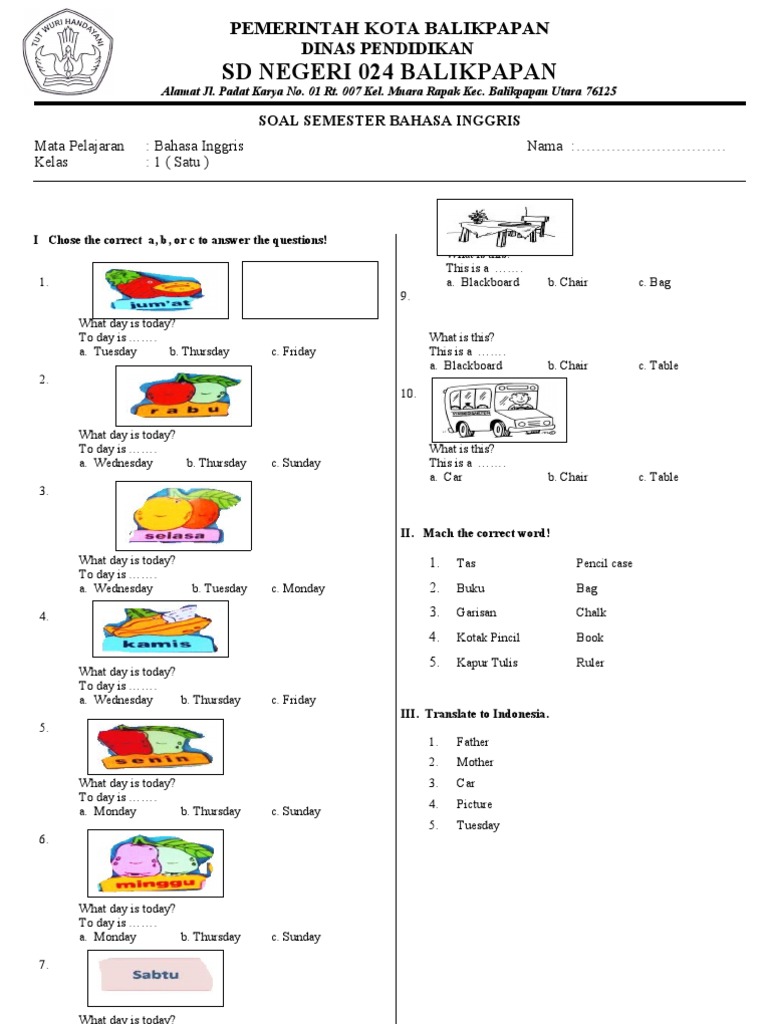a. Importance of English Language Learning
b. Scope of the Article: Grade 4, Semester 2 English Exercises
II. Vocabulary Exercises
a. Matching words with pictures
b. Fill in the blanks with appropriate vocabulary
c. Sentence completion using vocabulary
d. Example exercises with answer keys
III. Grammar Exercises
a. Simple Present Tense
i. Affirmative sentences
ii. Negative sentences
iii. Interrogative sentences
iv. Example exercises with answer keys
b. Simple Past Tense
i. Regular verbs
ii. Irregular verbs
iii. Example exercises with answer keys
c. Plural Nouns
i. Regular plural nouns
ii. Irregular plural nouns
iii. Example exercises with answer keys
d. Question Words (What, Where, When, Who, Why, How)
i. Forming questions using question words
ii. Answering questions using appropriate information
iii. Example exercises with answer keys
IV. Reading Comprehension Exercises
a. Short stories with comprehension questions
b. Identifying main ideas and supporting details
c. Inferencing meaning from context
d. Example exercises with answer keys
V. Writing Exercises
a. Sentence writing using given words
b. Paragraph writing based on pictures or prompts
c. Simple story writing
d. Example exercises with answer keys
VI. Conclusion
a. Recap of the covered exercises
b. Importance of consistent practice
Grade 4 Semester 2 English Exercises
I. Introduction
Learning English is crucial in today’s globalized world. Proficiency in English opens doors to various opportunities, enhancing communication skills and broadening access to information and resources. This article provides a comprehensive collection of English language exercises suitable for Grade 4 students in their second semester. The exercises cover a range of essential skills, including vocabulary, grammar, reading comprehension, and writing, designed to reinforce classroom learning and promote independent study.
II. Vocabulary Exercises
Building a strong vocabulary is foundational to English language acquisition. These exercises focus on expanding Grade 4 students’ word power through diverse activities.
a. Matching words with pictures: Students match vocabulary words (e.g., apple, banana, cat, dog) with corresponding pictures. This exercise helps visual learners connect words with their meanings.
Example: Match the words below with the correct pictures.
Words: sun, tree, flower, bird
(Pictures of a sun, a tree, a flower, and a bird would be included here.)
b. Fill in the blanks with appropriate vocabulary: Students fill in blanks in sentences using a provided word bank. This exercise tests their understanding of vocabulary in context.
Example: Fill in the blanks with words from the box below.
Box: big, small, happy, sad
- The elephant is a ___ animal.
- The mouse is a ___ animal.
- The girl is ___ because she got a new toy.
- The boy is ___ because he lost his ball.
Answer Key: 1. big, 2. small, 3. happy, 4. sad
c. Sentence completion using vocabulary: Students complete sentences using appropriate vocabulary words to create meaningful sentences. This exercise assesses their ability to use words accurately in context.
Example: Complete the sentences using the words: beautiful, quickly, carefully.
- The butterfly has ___ wings.
- The rabbit ran ___ away from the fox.
- The child handled the glass ___.
Answer Key: 1. beautiful, 2. quickly, 3. carefully
III. Grammar Exercises
Grammar forms the backbone of language structure. These exercises reinforce fundamental grammatical concepts for Grade 4 students.
a. Simple Present Tense: This tense describes habitual actions or general truths.
i. Affirmative sentences: (e.g., I eat breakfast every morning.)
ii. Negative sentences: (e.g., I do not eat sweets.)
iii. Interrogative sentences: (e.g., Do you eat vegetables?)
Example: Write the sentences in simple present tense.
- (He/play) football every Saturday.
- (She/not/like) spicy food.
- (They/go) to school by bus?
Answer Key: 1. He plays football every Saturday. 2. She does not like spicy food. 3. Do they go to school by bus?
b. Simple Past Tense: This tense describes actions completed in the past.
i. Regular verbs: (e.g., I walked to school.)
ii. Irregular verbs: (e.g., I ate an apple.)
Example: Write the sentences in simple past tense.
- I (watch) a movie last night.
- She (go) to the park yesterday.
- We (eat) pizza for dinner.
Answer Key: 1. I watched a movie last night. 2. She went to the park yesterday. 3. We ate pizza for dinner.
c. Plural Nouns: This section covers forming plural nouns.
i. Regular plural nouns: (e.g., cat – cats)
ii. Irregular plural nouns: (e.g., child – children)
Example: Write the plural form of the following nouns.
- dog
- box
- woman
- tooth
Answer Key: 1. dogs, 2. boxes, 3. women, 4. teeth
d. Question Words (What, Where, When, Who, Why, How): These words initiate questions seeking specific information.
Example: Answer the questions using the information provided.
Information: My name is John. I live in London. I went to the park yesterday. I went to the park because it was sunny. I went by bus.
- What is your name?
- Where do you live?
- When did you go to the park?
- Why did you go to the park?
- How did you go to the park?
Answer Key: 1. My name is John. 2. I live in London. 3. I went to the park yesterday. 4. I went to the park because it was sunny. 5. I went by bus.
IV. Reading Comprehension Exercises
Reading comprehension exercises enhance understanding and interpretation skills.
a. Short stories with comprehension questions: Students read short stories and answer questions testing their understanding of the plot, characters, and setting.
b. Identifying main ideas and supporting details: Students identify the central theme and supporting evidence within a text.
c. Inferencing meaning from context: Students deduce meanings of unfamiliar words or concepts based on surrounding text.
Example: Read the story and answer the questions. (A short story would be included here, followed by comprehension questions.)
V. Writing Exercises
Writing exercises promote fluency and accurate expression.
a. Sentence writing using given words: Students create sentences using a set of provided words.
b. Paragraph writing based on pictures or prompts: Students write paragraphs based on visual cues or writing prompts.
c. Simple story writing: Students write short stories based on given themes or characters.
Example: Write a sentence using the words: cat, sat, mat.
Answer Key: The cat sat on the mat.
VI. Conclusion
This article provided a range of exercises designed to help Grade 4 students improve their English language skills during the second semester. These exercises cover vocabulary, grammar, reading comprehension, and writing. Consistent practice and engagement with these exercises are key to mastering the English language. Regular review and seeking assistance when needed are crucial components of successful language learning. Remember, consistent effort is the key to achieving fluency and confidence in English.



